The beach
Kitroplatia beach is located in the eastern part of Agios Nikolaos, about 800 meters from city’s main square. Kitroplatia beach is one of the most cosmopolitan beaches of Agios Nikolaos and has sand and fine gravel. There are various catering businesses near the beach like taverns and cafes.
The beach access is quite easy, as it is located into the urban tissue and the bathers can be arrived there either using a bicycle, on foot, or by public transport, by bike and by car.
BEACH FACILITIES
BEACH INFORMATION
The Municipality of Agios Nikolaos is one of the most beautiful municipalities of the Region of Crete and is the capital of LasithiPrefecture. The extent of the municipality is 511.99 m2. Part of the municipality of Agios Nikolaos are the communities of Kritsa, Elounda, Limnes, Kalo Chorio, Vrouchas, Skinias, Louma, Zenia, Exo Potamion, Kroustas, Exo Lakonia, Mesa Lakonia, Prina, Neapolis and Vrahassi. Capital of the new Municipality of Agios Nikolaos is the city of Agios Nikolaos while the historic capital of the Municipality is Neapolis.
In ancient years the city of “Lato pros Kamara” flourished, which was situated upon the current town of Agios Nikolaos. It was placed on the hill between the lake and the marina, but only a few findings have survived from this ancient city. The city “Lato pros Kamara” was the port of the major Dorian city Lato (Lato or Etera) near Kritsa village (10 km. South of Agios Nikolaos).
In 1206 Henry Pescatore, a Genovese pirate, built a fortress on the top of the hill, where the building of Prefecture stands today. The fortress was named Mirabello, due to the unique view to the entire bay. This fortress should have been really impressive, as the whole Province of Agios Nikolaos received the name Mirabello. Inside the fortress, there was a salt warehouse, where was carefully stored the valuable product from the salt marshes of Elounda.
The Mirabello fortress faced several disasters, an earthquake in 1303 and a pirate capture in 1537, but it was always rebuilt. The final destruction of it was in the 17th AD century, when the Ottomans besieged it and conquered it after betrayal.
The early years of the Turkish conquest, Mirabello continued to be inhabited and was also the seat of the Province, but gradually it was deserted and there are a lot of reports of the complete abandonment of the city, but the port was still continued to be used for the exportation of the local products, mostly the locust. It is reported that the products were primarily collected in open areas, even within the four churches of Agios Nikolaos that were existed in that time, because there weren’t any warehouses.
At the end of the Ottoman rule and right after the Greek revolution of 1866, Agios Nikolaos inhabited again. The residents of Kritsa, some villagers from Sfakia and those who had engaged in shipping in eastern Crete, settled in the dilapidated village of Mandraki, which in the latest years developed into today’s city of Agios Nikolaos.
Agios Nikolaos is not an old name and the name of the city comes from the name of the nave church with a dome at the small Ammoudi peninsula, across from the coastal road.
In the 1960s Agios Nikolaos became the first tourism destination in Crete, earlier than the other areas of Crete, and the first major hotel had shortly opened in 1965. Still today Agios Nikolaos receives thousands of tourists every summer, as well as Elounda and Plaka in the north and Istro and Kalo Chorio in the south of Municipality.
The rest of the villages that are located in the hills and the mountains around Agios Nikolaos remain virtually untouched by tourism and they can offer to the visitors the opportunity to get a picture of real life in Crete.
The current city of Agios Nikolaos is built on the ancient Lato Kamara. From that time of period several statues, inscriptions and many tombs in the river region have been found. The offerings of the tombs, many of which are really interesting, exhibited at the Archaeological Museum of the city.
The monument of Spinalonga (fortified island) presents particular interest, which was used as a leper colony in the past. Particular interest also presents the cornucopia, a sculpture that had been made by the local artist’s brothers Sotiriadi and it was erected in a stone terrace by the sea. Moreover, in Elounda are located integers the well-known windmills. In Elounda’s “Channel” are saved three circle windmills, so their type is “round” or “xetrocharis”. The windmill was built in the early century.
Kitroplatia beach is located in the eastern part of Agios Nikolaos, about 800 meters from city’s main square. Kitroplatia beach is one of the most cosmopolitan beaches of Agios Nikolaos and has sand and fine gravel. There are various catering businesses near the beach like taverns and cafes.
The beach access is quite easy, as it is located into the urban tissue and the bathers can be arrived there either using a bicycle, on foot, or by public transport, by bike and by car.
As we contemplate the sea, on the right side of the beach starts along the coastline a beautiful stone promenade, ideal for walking and relaxation, which leads to Agios Nikolaos’ marine, while a few meters away from the left side of the beach, the visitors could meet the Sotiriadi brothers’ sculpture, which represents the Horn of Amalthea. Amalthea was the wet nurse of Zeus in the Ideon Andron, where his mother Rea had hidden him in order to escape from his father, Kronos, who were eaten his children. Amaltheia was described sometimes as nymph Yada or as a goat, which for his horn Zeus was fed with milk and honey.
The opening hours of the beach are from 10:30 to 17:30.
If you have any questions ask the beach staff
For any complaints complete the special form at the entrance
To help us increase the quality of the services provided please complete the relevant questionnaire which you can find at the reception or in our website www.costanostrum.org or by downloading the relevant application Costa Nostrum.
The ashtrays, the beach chairs and the umbrellas are property of DAEAN.
Only the guests – owners of valuable objects that may be lost, are responsible for the loss.
You should always follow the advice of the lifeguards.
Swim parallel to the coastline and if possible never alone.
It is prohibited to block the lifeguard’s corridor and the range of vision of the lifeguard.
The consumption of alcohol or drugs is prohibited.
It is prohibited to throw cigarettes into the sea or on the beach.
It is prohibited to throw glass objects or packaging on the beach or into the sea.
It is prohibited to throw any object on the beach or into the sea.
It is prohibited to light a fire.
It is prohibited to use shampoo at the showers.
It is prohibited to use music devices that produce loud noise.
All your rubbish should be placed with your own responsibility into the special waste containers.
It is prohibited to destroy any kind of vegetation.
It is prohibited to walk in areas where swimmers are not allowed to enter, according to the existing prohibition signs.
It is prohibited to stay on the lifeguard’s tower without a relevant permission.
The beach staff has the right to remove from the beach persons who are in a drunken condition or under the influence of drugs or behave violently/improperly to other visitors.
It is prohibited to take sand.
Pets should be tied, wearing a muzzle and their owners should have the relevant veterinary certificates. Free circulation of pets on the beach is strictly prohibited. If the dog annoys or the owner receives any remark, it should be immediately removed.
In case of a person disappearance, you should immediately contact the beach manager.
In case of a beach closure, please follow the instructions of the manager and lifeguards.
In case of an accident, you should immediately inform the lifeguard and the beach manager.
If a customer falls sick due to any possible cause, they are to immediately notify the beach manager, in order for all necessary measures to be taken.
According to some sources the name of the beach comes from the last century when into this area was citron market and due to the sea depth, the local merchants chartered commercial boats in order to export citrus preserved in brine, when the city hadn’t a harbor. Unfortunately, the last decade’s citrus, or “Mida’s apples”, the symbol of abundance and fertility, are not cultivated anymore, so only the square name remains to remind its existence to elders and teach the city’s history to young people.
Kitroplatia’s marine environment is particularly interesting, as it consists of rocky seabed up to 10 m. and right after that it develops a sandy Seagrass meadows bottom (Posidonia oceanica). The visitor has the ability to observe the abundant and spectacular marine biodiversity of the beach, which is located in the urban fabric in shallow waters, which is a rarely phenomenon for the urban beaches. The visitor could see rich algae formations on the rocks, sea urchins attached to positions that have grown seaweed, small fishes move to the clefts and crevices of rocks, different colors and shapes sponges attached on the rocks and carefully hidden crabs in crevices on the rocks seeking for food and covering from predators. Several times, from deeper waters, fish schools from white seabream arrive, while salema porgy and marble spinefoot are around the waters of 2 to 6-7 meters depth, feeding in the macrolagae, and source of their food. If the visitor is careful and observant, he will see hidden decorated octopus hles to lurk for their next prey.
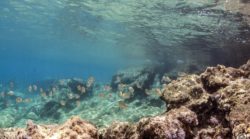
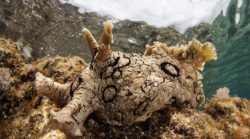
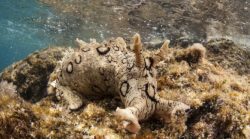
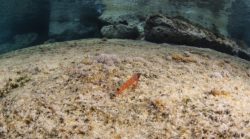
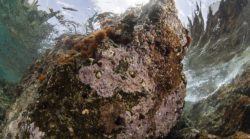
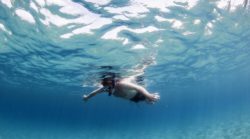

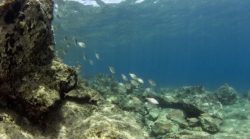
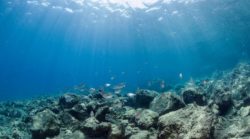
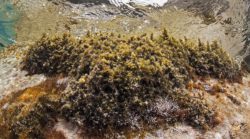
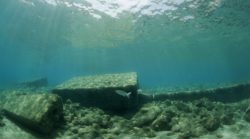
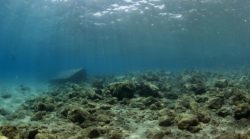
Kitroplatia’s land part is planted with tamarisks and the beach consists of medium-sized pebbles. Tamarisks are homed several small winged visitors and during the summer months they host cicads that are creating a musical feast.
For the term “load-bearing capacity” there is a large number of definitions in international literature. However, all these definitions involve two central opinions: Firstly, the biophysical element related to the maintenance of the integrity of the natural resource, in this case, the beach. So, there is a maximum limit which must not be exceeded or else the natural ecosystem will suffer strong pressures. And, secondly, behavioral element which reflects the ability of the leisure experience.
Although until today there has not been a widely accepted definition or a commonly accepted procedure for the calculation of the load-bearing capacity of the beach, the calculation of the load-bearing capacity of each beach is done with the combination of different procedures found in international literature, the main goal being the best protection and conservation of the natural resource and the environment.
For the calculation of the load-bearing capacity of this beach, the following data – information were considered;
Calculation practices of the load-bearing capacity of the beach, mentioned in international literature.
Legislation in force.
Geographical position of the beach.
Existence of endangered species inside the coastal zone.
Fauna and Flora of the area.
Environmental stress of the beach.
The best service of the guests – swimmers of the beach.
The protection of the environment and the preservation of the natural resources of the beach.
Existence of protection rules for the safety and easy access of the guests to the beach.
Existence of stable infrastructures and the prospect of placing new infrastructures like WC.
The total covered area of the beach is about 1800 m2.
Based on the calculation of the carrying capacity of this particular beach, according to the state of art, the carrying capacity is about 350 swimmers.
The number of umbrellas that the hotel gives to its guests is 60 umbrellas, that is, 120 beach chairs which corresponds to 120 swimmers. This number is much smaller than the capacity of the beach.
The main goal of the suggested management plan aims at the optimal sustainable management of the waste produced by visitors of the beach during their stay in the coastal zone.
The administrators of each beach must place appropriate bin for recycling where possible and to cover the needs of the beach at the same time.
It is suggested that in every beach – whether it is organized or not and taking into account the number of visitors – there are at least blue bins for the recycling of packaging , brown bins (compost bins) for the recycling of organic waste and green bins for mixed waste.
An important issue that the administrators have to deal with, whether they are public or private, is the collection of the cigarette ends which are thrown by the swimmers on the beach. It is suggested that there are ashtrays next to each chair which will be cleaned by the beach staff, after the guests leave the beach. This waste should not be thrown in the bin with the mixed rubbish because they can cause fire. They should be put in a special metal bucket, soaked with water and then thrown into the common bins, as no management plan for this kind of waste has been found until now.
At the point where the bins are placed there should be explanatory signs in more languages and the waste should be carried to the recycling centers regularly.
Moreover is should be mentioned that the seaweeds washed out at the beach are not beautiful but there is a processing method by a Greek company producing compost from seaweeds, http://www.compost.gr/#!unique-method-gr/co9t .
In general, it is suggested the following bins are placed:
At least 1 Green bin for mixed rubbish
At least 1 Blue bin for recyclable package materials
At least 1 Brown bin for organic waste
At least 1 Metal bucket for cigarettes from the ashtrays placed under the umbrellas
Clay ashtray at each beach chair set.
1 butterfly net so that the staff can collect rubbish from the beach without bending.
One-use gloves in case the worker has to collect rubbish with the hands.
All the bins should always be closed and the administrator of the beach is responsible to make sure the bins are closed.
Any other waste like batteries, electrical and electronic equipment should be given at the reception and the administrator of the beach has the responsibility to put them in the right bin, or inform the guest where the nearest container is.
In any case no rubbish should be thrown into the wrong container and of course nothing should be thrown into the beach or the sea.
At the beach of Kitroplatia no existence of endangered species has been mentioned. In any case, if endangered species appear, then measures for their protection have to be taken.
For example, some measures are mentioned below but in any case if you find an endangered species you should immediately contact the competent authorities of the state.
If you find a nest
If the nest is in danger beacause of the pedestrians or the vehicles, surround it with a “fence” you can make from wooden sticks placed around it and tied with some rope.
CAREFUL: Do not dig the nest. If there are stones or other things that may prevent the baby turtles from finding their way to the sea, then remove those obstacles.
If it is in the shade (e.g. under an umbrella), try to remove it.
If you find an injured turtle
You put the turtle in a SAFE PLACE away from people and noise. YOU ALWAYS RAISE IT FROM THE SHELL (never from the wings or the head).
If the animal is big it must be carried by 2 persons by catching the shell from behind the neck and over the tail.
YOU PLACE THE ANIMAL CAREFULLY making sure the wings do not remain under its body.
We put the animal in a place which is PROTECTED AND QUIET, AWAY FROM STREAMS AND WIND. In the summer months you should cover the would with a piece of WET CLOTH. The temperature of the place should not fall under 15 degrees Celcius. The turtle does not have to be put in sea water and if it is wounded at the head or exhausted, it MUST NOT BE PUT IN WATER BECAUSE IT MY DROWN.
If it is trapped in nets or fishing hook, you remove them carefully. In no circumstances should you TRY TO PULL A HOOK FROM THE MOUTH OR TAIL.
You control all wings and if you find RECOGNITION TAGS call the Rescue Network (210 8944444). You will be sent a special form which you have to COMPLETE carefully to help the turtle you found and also other turtles.
If you find a dead sea turtle
If the turtle is dead it should be CARRIED TO THE LAND and the Coast Guard as well as Archelon should be contacted. BE CAREFUL, IT IS POSSIBLE THAT THE TURTLES LOOKS DEAD BUT IT MAY BE IN DEEP SLEEP, ESPECIALLY IN THE COLD MONTHS.
YOU SHOULD CALL THE OFFICIAL VETERINARIAN AND IF THERE IS NOT ONE, YOU CALL ANOTHER VETERIANARIAN OR THE COAST GUARD. .
If you find a tag it should be removed and sent to ARCHELON.
ATTENTION, THIS IS ONLY FOR DEAD ANIMALS. It would be very helpful for ARCHELON if you take a photograph of the animal and especially its wounds.
Complete the special FORM sent to you by ARCHELON AND finally call the LOCAL AUTHORITIES for the burial of the animal.
For more information http://www.archelon.gr/ .
There isn’t any wetland near Kitroplatia Beach.